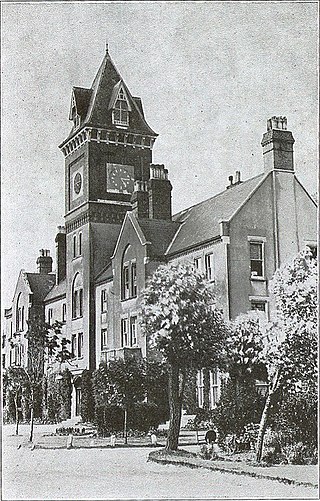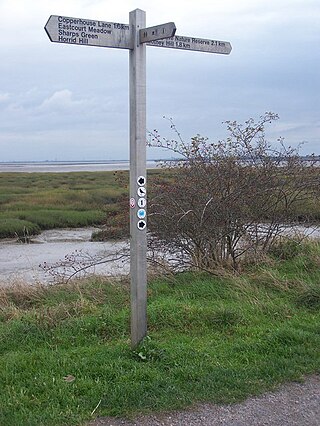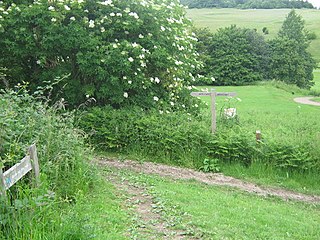
Swanscombe /ˈswɒnzkəm/ is a village in the Borough of Dartford in Kent, England, and the civil parish of Swanscombe and Greenhithe. It is 4.4 miles west of Gravesend and 4.8 miles east of Dartford.

The Darent is a Kentish tributary of the River Thames and takes the waters of the River Cray as a tributary in the tidal portion of the Darent near Crayford. 'Darenth' is frequently found as the spelling of the river's name in older books and maps, Bartholomew's Canals and River of England being one example. Bartholomew's Gazetteer (1954) demonstrates that Darent means "clear water", a result of it springing from and running through chalk. The purity of the water was a major factor in the development of paper and pharmaceuticals in the area.

Greenhithe is a village in the Borough of Dartford in Kent, England, and the civil parish of Swanscombe and Greenhithe. It is located 4 miles east of Dartford and 5 miles west of Gravesend.

Swanley is a town and civil parish in the Sevenoaks District of Kent, England, 16 miles (26 km) southeast of central London, adjacent to the Greater London boundary and within the M25 motorway periphery. The population at the 2021 census was 17,826.
Cuckmere Valley is a civil parish in the Wealden District of East Sussex, England. As its name suggests, the parish consists of a number of small settlements in the lower reaches of the River Cuckmere.

Dartford is the principal town in the Borough of Dartford, Kent, England. It is located 18 mi (29 km) south-east of Central London and is situated adjacent to the London Borough of Bexley to its west. To its north, across the Thames estuary, is Thurrock in Essex, which can be reached via the Dartford Crossing. To its east lies the Borough of Gravesham and to the south the district of Sevenoaks. It had a population of 51,240.

Darenth Park Hospital was a healthcare facility in Darenth near Dartford in Kent, originally founded as Darenth School.
Valerius and Rufinus are venerated as Christian saints and martyrs. Their legend states that they were imperial tax collectors in Soissons who were pious Christians. They were ordered to be arrested by Rictius Varus, the praefectus-praetorii in Gaul. The two saints hid themselves but were eventually caught, and then tortured and beheaded on the high road leading to Soissons.

St John's Jerusalem or Sutton-at-Hone Preceptory is a National Trust property at Sutton-at-Hone, Kent, England which includes the 13th century chapel of the Knights Hospitaller and a garden moated by the River Darent. The chapel and garden are open to the public.

Clayton to Offham Escarpment is a 422.5-hectare (1,044-acre) linear biological Site of Special Scientific Interest (SSSI) which runs from Clayton in West Sussex to Lewes in East Sussex. Its ownership and management is divided between over fifteen landowners and farmers. Parts of Ditchling's Downs, e.g. TQ 323 133, and the scarp between Blackcap and Mount Harry, e.g. TQ 378 124, are owned by the National Trust. What remains of Ditchling Tenantry Down common at Ditchling Beacon is leased to the Sussex Wildlife Trust.

Riverside Country Park is a large coastal public park, situated alongside the River Medway estuary between Gillingham and Rainham. The park covers about 100 hectares - approximately 247 acres (1.00 km2). There are a variety of natural habitats within the park, including mudflats and salt marsh, ponds and reed-beds, grassland and scrub, which provide a haven for wildlife.

Shorne Woods Country Park is located between Strood and Gravesend, in the English county of Kent. It was once part of a large estate, later passed to the county council to be used as a country park.

Beacon Wood Country Park is a public woodland in Bean near Dartford, in Kent, England. It was previously an industrial claypit then re-claimed as woodland park open to the public, currently owned by Tarmac.

Lullingstone Country Park is near Eynsford, in Kent, England. A former deer park of a large estate, it was later sold to become an open-space and woodland park. The park and Lullingstone Castle are a Scheduled Monument, and an area of 66.4-hectare (164-acre) is a biological Site of Special Scientific Interest Kent.

Preston Hill Country Park is in Eynsford, in Kent, England. It is a woodland and former military firing range.
Northfleet Urban Country Park is in Northfleet, in Kent, England. The site is land encompassed by Springhead Road, Thames Way, west of Vale Road and the railway . The site is owned by and managed by Gravesham Borough Council.
Finglesham Anglo-Saxon cemetery is a place of burial that was used from the sixth to the eighth centuries CE. It is located adjacent to the village of Finglesham, near Sandwich in Kent, South East England. Belonging to the Anglo-Saxon period, it was part of the much wider tradition of burial in Early Anglo-Saxon England.

Darent Valley Hospital is a 478-bed, acute district general hospital in Dartford, Kent, England. The hospital has an Emergency Department. The hospital is managed by the Dartford and Gravesham NHS Trust.

Dartford Heath Common is an area of open heathland situated to the south-west of Dartford, Kent, England, that covers around 314 acres (127 ha) of open space. Dartford Heath is classified as lowland heath and is one of only two substantial heathland blocks remaining in Kent. The heath supports a number of rare plants and invertebrates, as well as reptiles, including the common lizard and slow-worm, and rabbits.

The Kingston Brooch is the largest known Anglo-Saxon composite brooch, and is considered by scholars to be an outstanding example of the composite disc brooch style. Over time, the Kingston brooch has become widely recognized for its charm, inherent value and detailed workmanship. The brooch, created in the seventh century, is now in the World Museum Liverpool in Liverpool, England.















